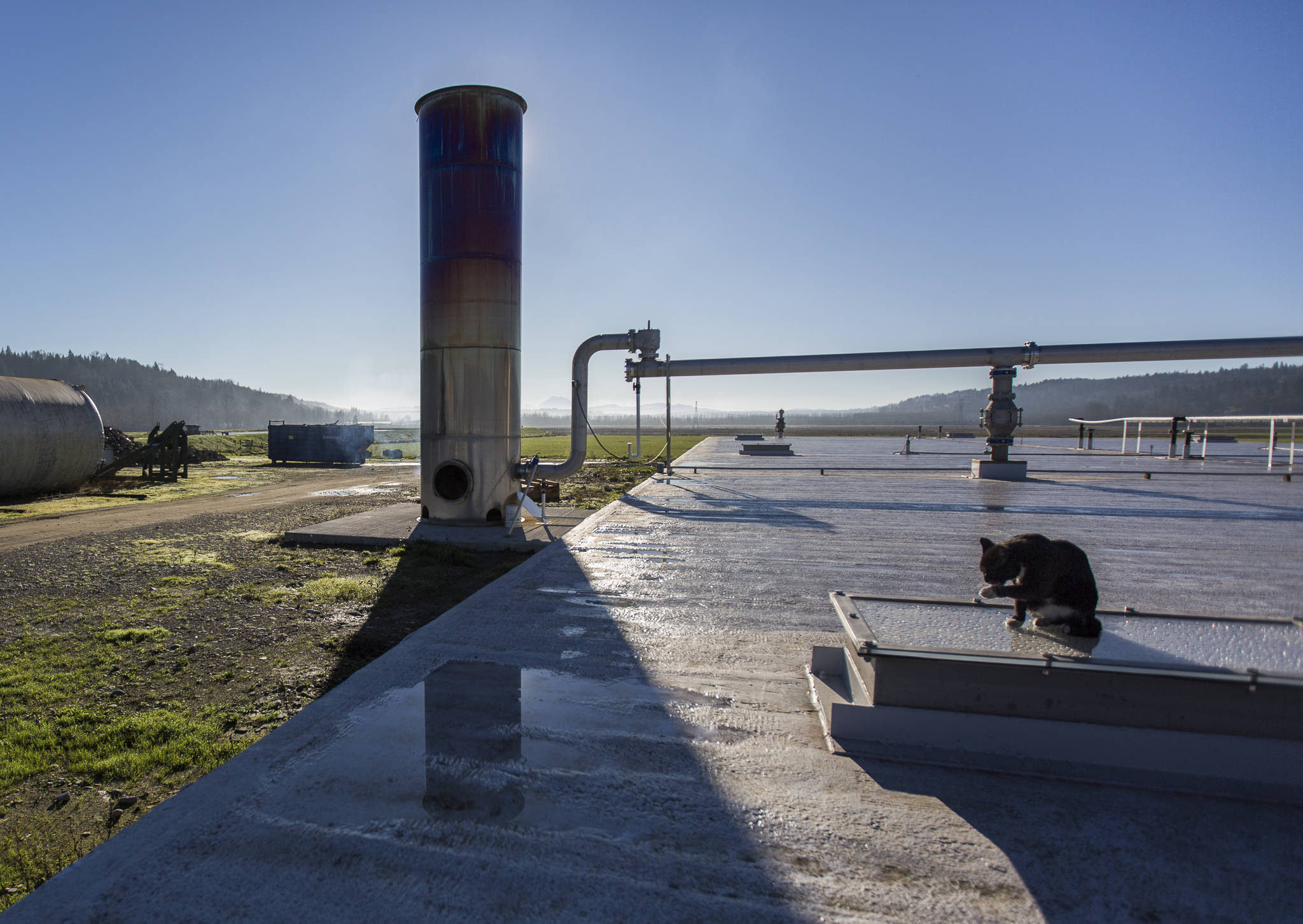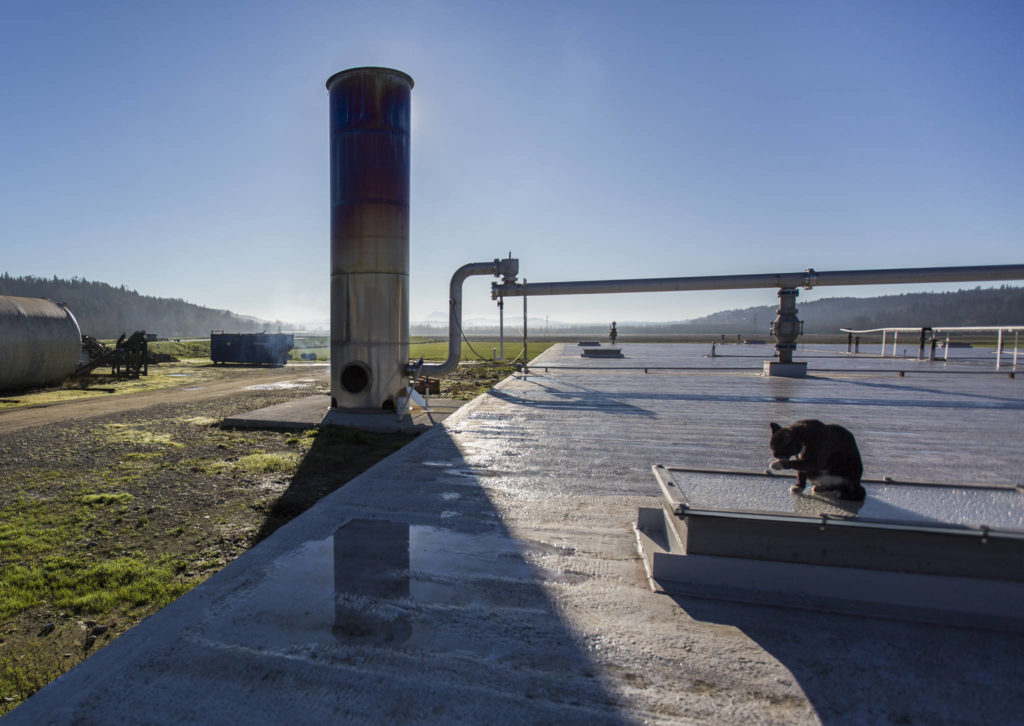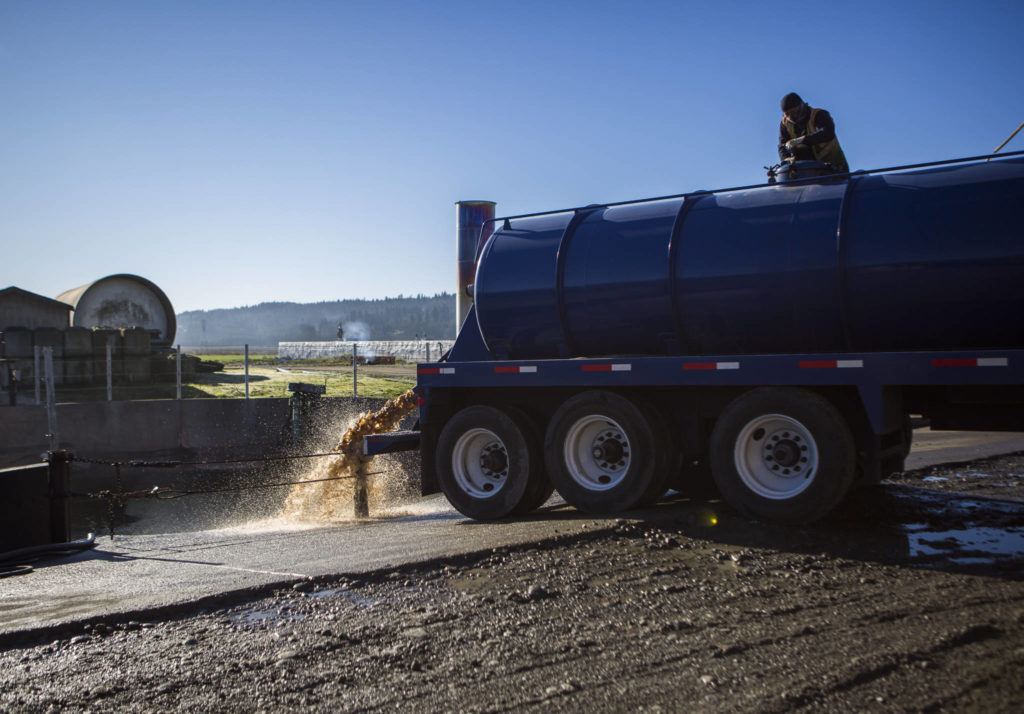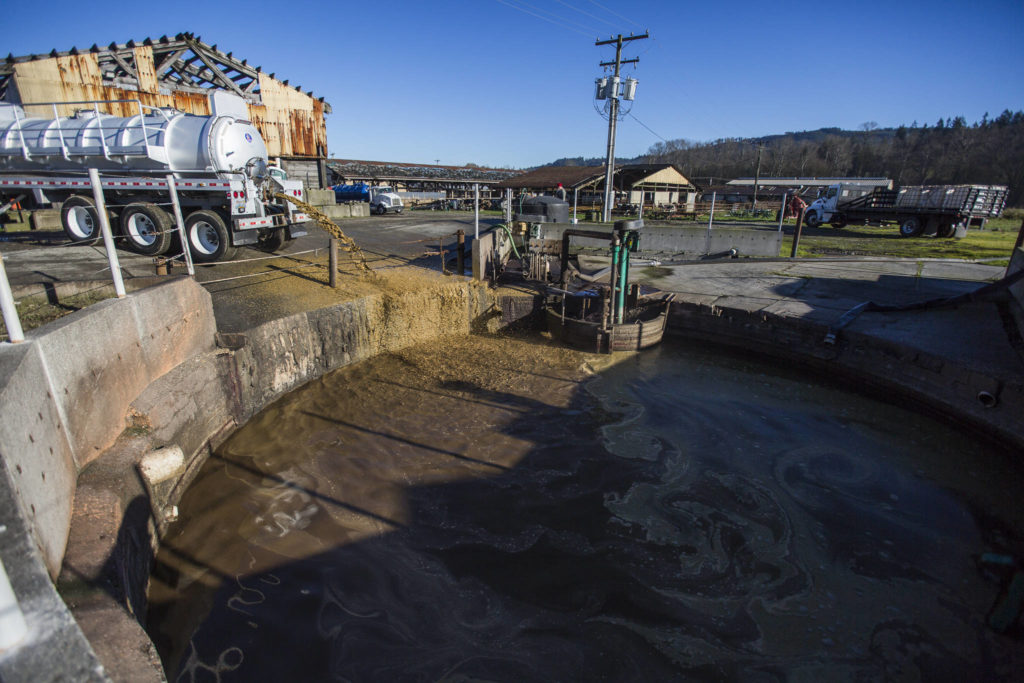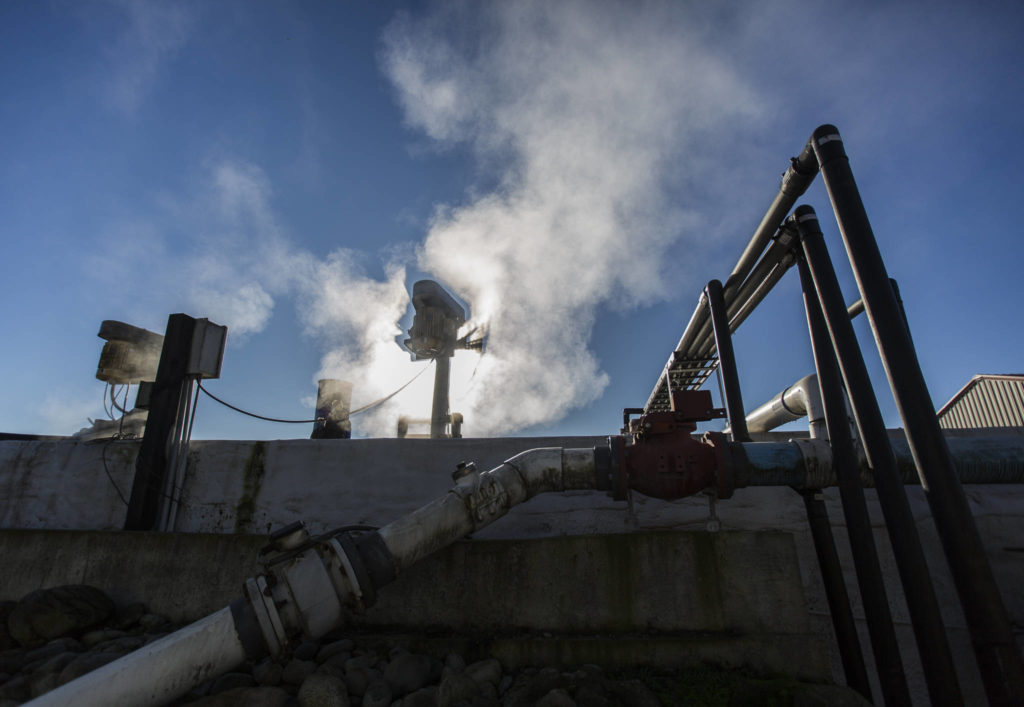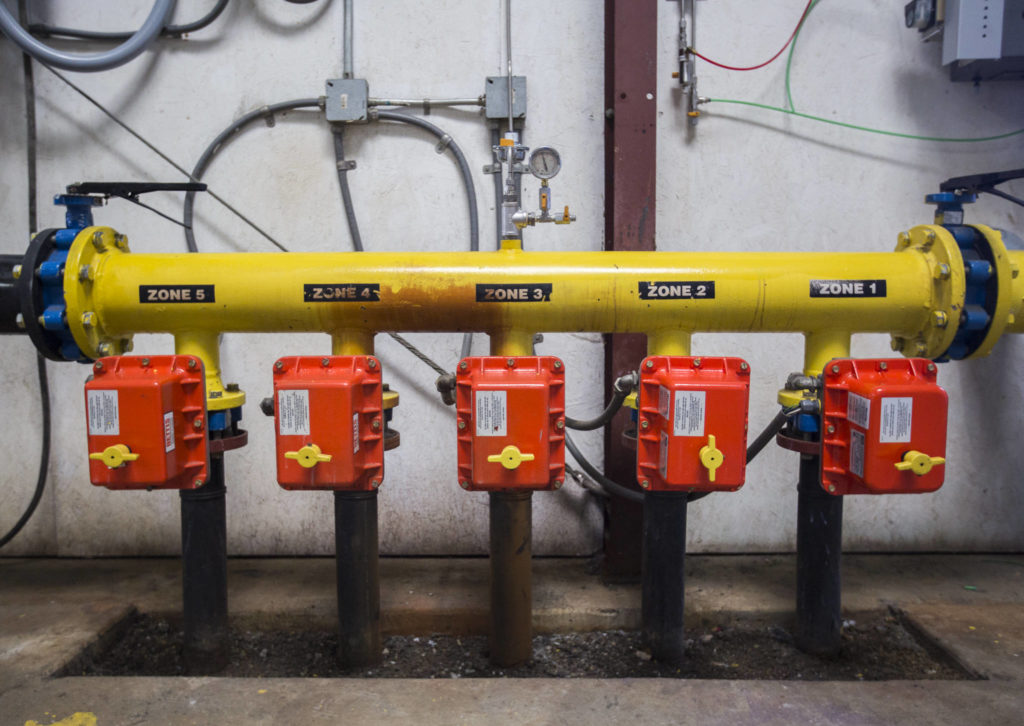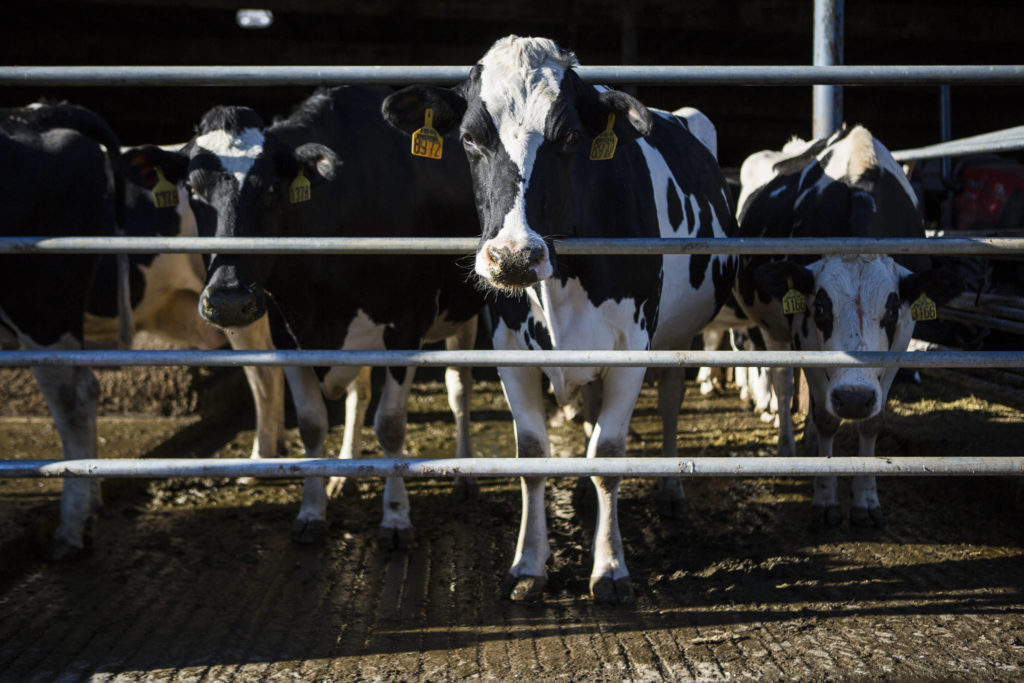MONROE —The black-and-white patched faces of 400 dairy cows peered out curiously from their barn last week, ears flicking nervously at faces they didn’t recognize. These cows, along with 2,000 others at Werkhoven Dairy locations, help generate enough electricity to power 300 homes.
Using an anaerobic digester, Werkhoven works with the Tulalip Tribes to turn cow manure and food waste into power. And through an upcoming partnership, the Snohomish County Public Utility District plans to double that capacity and harness it for customers.
An unlikely partnership
Jon Van Nieuwenhuyzen is the third generation to help run the Werkhoven family’s 2,000 acres in Snohomish County.
In the 1990s, the Skykomish River washed out one of the family’s larger pastures. As they patched up their farm, they also worked with the Tulalip Tribes to restore the river bank and Haskel Slough.
That project ignited the potential for a long-term partnership focused on taking care of the environment.
“We’re trained to be stewards for what we have,” Van Nieuwenhuyzen said. “On the farm, we have to be stewards of the soil, the water, otherwise it doesn’t produce food for the cows. And we have to be stewards for the animals, otherwise they don’t produce food for us.”
That’s something the Werkhoven family and the Tulalip Tribes agreed on.
“It morphed into something that’s really unique that you don’t really see around the country, which is farmers and tribes working together,” Van Nieuwenhuyzen said. “It’s different entities working toward common goals, but each of us has different interests that feed our families.”
After several years of talking, they decided to build an anaerobic digester in the early 2000s. It’s a mechanism that breaks down organic material — in this case, cow manure and food waste — into liquid fertilizer and methane gas, which is converted to electricity.
At the time, the digester was brand new technology.
“They were one of the first to build a digester,” said Scott Spahr, the generation engineering manager at the Snohomish County PUD.
Without many examples, the farmers and tribal members weren’t sure how much the digester would produce.
But the tribes took over an abandoned prison site in Monroe in 2008, and the newly formed partnership got to work.
They named it Qualco— “where two rivers come together” in Lushootseed, the language of the Coast Salish people.
It speaks to the project’s physical location at the confluence of the Skykomish and Snoqualmie rivers, Van Nieuwenhuyzen said, and to farmers and tribes joining to sustain one another and the environment.
Waste in, power out
The Werkhoven family knows cows, and the digester is basically a giant cow stomach.
The digester grows anaerobic bacteria, which break down material just as the rumen in a cow’s four-compartment stomach does, Van Nieuwenhuyzen said.
And like cows, the digester has an appetite.
It “eats” over 22,000 gallons of food waste per day, from unsellable grocery store produce to millions of gallons of off-spec wine.
The majority of the digester’s diet, about 70%, comes from 60,000 gallons of manure per day created by the 2,300 cows on Werkhoven farms.
The process begins in the cow barns.
Each day, recycled water is flushed over the floors, washing sand and manure on three different farms into pipes, where it’s separated and directed 1.5 miles to a pit beside the digester. There, it’s mixed by a giant turbine with all the food waste that’s hauled in.
From the pit, the slurry of organic matter enters a horseshoe-shaped sealed chamber, 16 feet deep and holding 1.5 million gallons, that’s heated to 100 degrees by hot water pipes. In that warm, cozy environment, bacteria thrive. They begin to excrete acid, breaking down the organic matter and creating methane gas in the process. That gas is directed to a generator, where it’s converted to electricity and sent directly to power lines. The exhaust from the engine warms the water that heats the digester chamber.
That entire process, from one tip of the horseshoe to another, takes 18 to 20 days.
The digester’s benefits are three-fold: It creates superior fertilizer for the farms, generates power for the PUD and reduces stream pollution. The process also creates carbon credits available for purchase by other companies.
Normally, farms disperse cow manure straight onto their fields as fertilizer. But as it breaks down, it releases methane gas into the air. As it sits on the pasture, rain and flooding could wash bacteria into nearby streams.
“It takes one to one and a half years for manure to benefit crops,” said Daryl Williams, Tulalip’s Qualco environmental liaison. “Meanwhile, floods wash it into the river.”
Through the digester process, manure breaks down into a liquid fertilizer that is quickly absorbed by crops, reducing the potential of stream contamination.
It’s also a more precise way to farm, Van Nieuwenhuyzen said. The farmers know exactly what’s in the liquid fertilizer, and they can track its application through flow meters and pumps.
The precision saves money and helps the Werkhoven dairies stay afloat in an increasingly low-margin business. In the 1980s, Snohomish County had over 70 dairy farms, Van Nieuwenhuyzen said. Now there are fewer than 20.
With the digester, the farm hardly needs to purchase any outside fertilizer. And they can apply exactly what their corn silage crops need, ensuring premium quality cow feed.
“Healthy cows mean milk that pays the bills,” Van Nieuwenhuyzen said.
Consistent and reliable
The PUD first started buying the power generated by the digester in 2014, seeing an opportunity to diversify its renewable energy portfolio.
“It’s really a natural fit for the PUD,” Spahr said.
Unlike solar, hydro and wind-generated energy, the digester is consistent and reliable.
“It’s a renewable that’s really steady,” Spahr said.
And since the digester is local, it cuts out the 2% transmission line energy losses associated with projects outside Snohomish County.
With 12 years of daily wear and tear, the digester’s aging generator limits the amount of energy it can create.
That’s where the PUD’s new partnership comes in.
The district plans to build a new generator, nearly doubling the digester’s output. It will create enough power to continuously power about 600 homes, Spahr said.
Meanwhile, Qualco spent half a million dollars over the past year rebuilding the digester, replacing outdated pipes and upgrading monitoring equipment.
“It was the iPhone 1 and now there’s an iPhone 12 out,” Van Nieuwenhuyzen said. “We needed an upgrade.”
The digester will play a key role in helping the PUD get to 100% carbon-free by 2045, as required by Washington’s Clean Energy Transformation Act, Spahr said.
The utility and Qualco are working together to develop a final agreement for building the generator, and plan to present it to the PUD Board of Commissioners in early 2021.
Julia-Grace Sanders: 425-339-3439; jgsanders@heraldnet.com; Twitter: @sanders_julia.
Talk to us
> Give us your news tips.
> Send us a letter to the editor.
> More Herald contact information.
